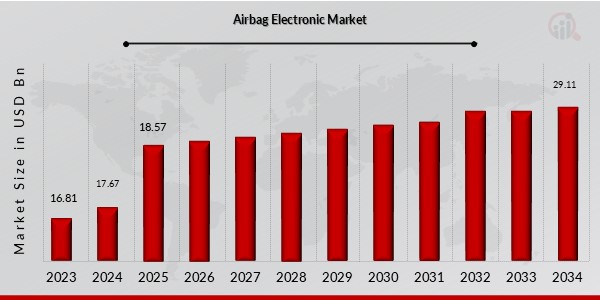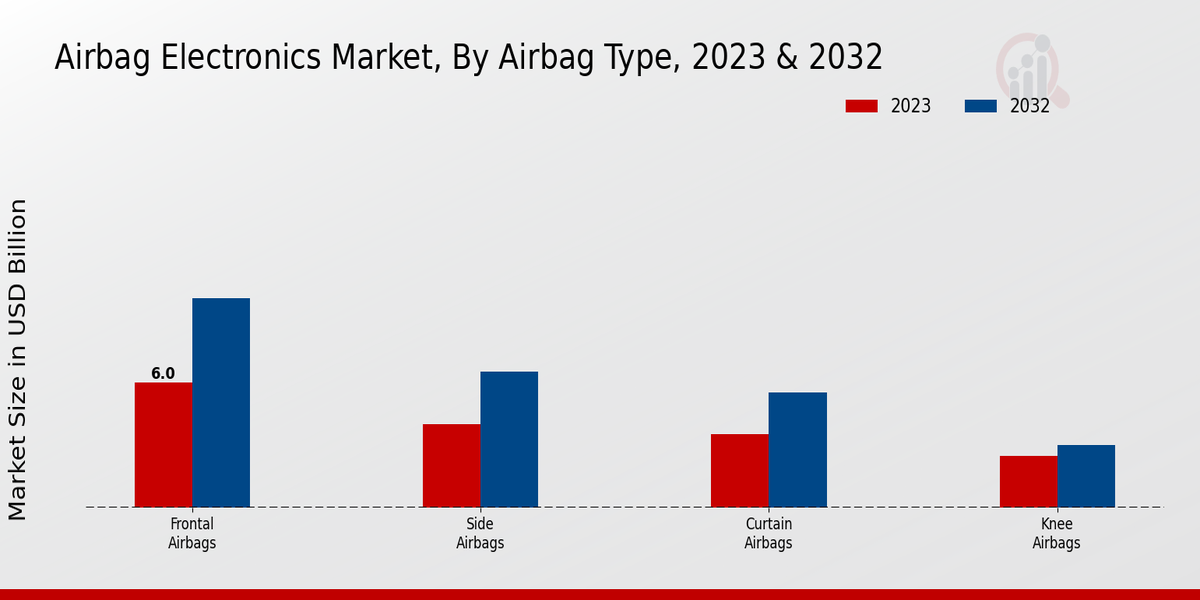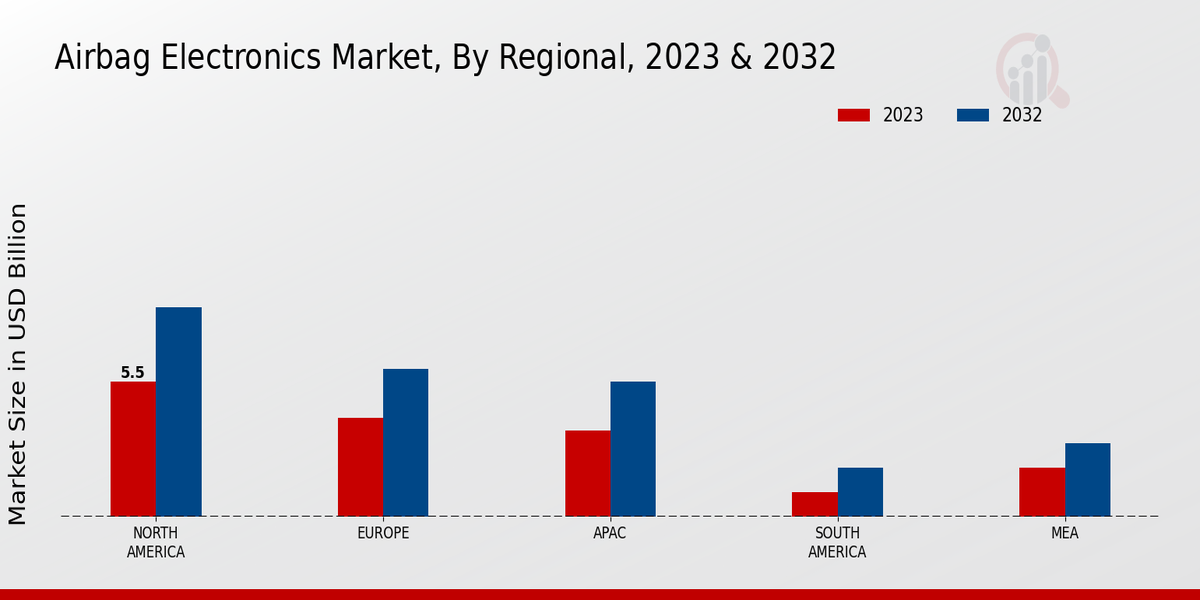Global Airbag Electronic Market Overview
The Airbag Electronics Market Size was estimated at 17.67 (USD Billion) in 2024. The Airbag Electronics Market Industry is expected to grow from 18.57 (USD Billion) in 2025 to 29.11 (USD Billion) by 2034. The Airbag Electronics Market CAGR (growth rate) is expected to be around 5.1% during the forecast period (2025 - 2034).

Source Primary Research, Secondary Research, MRFR Database and Analyst Review
Key Airbag Electronics Market Trends Highlighted
The Airbag Electronics Market is influenced by several key market drivers, including the increasing focus on vehicle safety and rising consumer awareness about the importance of advanced safety features in automobiles. As governments worldwide implement stricter safety regulations and standards, automakers are compelled to enhance their airbag systems, leading to greater integration of advanced electronics.
Additionally, technological advancements in sensor technology and electronics significantly contribute to the growth of this market. Enhanced sensor systems allow for quicker detection of accidents, improving airbag deployment timing and efficiency, which is vital for occupant safety.There are opportunities to be explored in the realm of developing new airbag technologies, such as adaptive airbags that can modify deployment based on specific accident conditions or passenger characteristics. Collaborative ventures between automotive and technology companies can further advance the integration of innovative electronics into airbag systems. Furthermore, the growth of electric and autonomous vehicles presents a unique opportunity for customized airbag solutions that cater to the specific safety needs of these vehicles, as traditional designs may not be entirely effective in new operating environments. Recent trends indicate a shift towards increasing digitization and connectivity within automotive safety systems.The emergence of smart airbags that can communicate with other vehicle systems represents an important evolution in safety technology, enhancing the overall safety framework of vehicles. Additionally, ongoing research into materials for airbags is paving the way for lighter, more effective designs. As the market evolves, sustainability concerns also prompt manufacturers to explore eco-friendly materials and manufacturing processes. The combination of these trends is shaping the future landscape of the Airbag Electronics Market, aiming for improved safety and efficiency in vehicle design.
Airbag Electronics Market Drivers
Increase in Vehicle Production and Sales
One of the most significant drivers for the Airbag Electronics Market Industry is the continuous increase in vehicle production and sales across the globe. As more consumers opt for personal vehicles for transportation, OEMs (Original Equipment Manufacturers) are producing more cars and incorporating advanced safety features, including airbag electronics, into their designs. This trend is significantly influenced by rising consumer awareness regarding road safety, government regulations mandating safety features in vehicles, and an increasing focus on enhancing passenger protection.The growth in emerging economies contributes to this trend, where automobile ownership is on the rise. With the market projected to grow considerably, automakers are prioritizing the integration of advanced airbag systems, which directly boosts demand for airbag electronics. As countries update their vehicle safety regulations and modernize their fleets, the emphasis on integrating sophisticated airbag systems can greatly enhance the appeal of new vehicle models, ensuring that manufacturers prioritize airbag technology further.Thus, the overall growth in vehicle production and sales presents a fertile ground for the expansion and evolution of the Airbag Electronics Market industry.
Technological Advancements in Airbag Systems
The Airbag Electronics Market Industry is experiencing rapid technological advancements that enhance airbag activation systems and passenger safety. Innovations such as advanced sensor technologies, smart airbags, and integration with vehicle control systems are gaining traction. These advancements improve airbag performance, timing, and deployment strategies, which significantly increase their effectiveness in accident scenarios. As technology continues to evolve, manufacturers are compelled to adopt these innovations, driving the demand for advanced airbag electronics.
Rising Consumer Awareness About Safety Features
Growing consumer awareness regarding vehicle safety features plays a crucial role in shaping the Airbag Electronics Market Industry. Today's consumers are more informed and prioritize safety measures in their vehicle choices. With the increasing number of road traffic accidents, individuals are demanding vehicles equipped with robust safety features, including modern airbag systems. Automakers are thus focusing on enhancing airbag technologies to meet consumer demands, leading to market growth.
Airbag Electronics Market Segment Insights
Airbag Electronics Market Airbag Type Insights
The Airbag Electronics Market has highlighted the critical role of various airbag types, particularly in enhancing vehicle safety. In 2023, the overall market was valued at 15.98 USD Billion, showcasing substantial demand for advanced airbag systems. Among the specific airbag types, Frontal Airbags stand out with a valuation of 6.0 USD Billion in 2023, expected to rise to 10.0 USD Billion by 2032, indicating their dominance in the market due to their essential role in protecting occupants during frontal collisions. Side Airbags also play a significant role, recording a valuation of 4.0 USD Billion in 2023 and projected to reach 6.5 USD Billion by 2032, reflecting an increasing focus on side-impact safety as more vehicles are equipped with this technology.Meanwhile, Curtain Airbags, valued at 3.5 USD Billion in 2023 and anticipated to climb to 5.5 USD Billion in 2032, have gained traction as they provide significant head protection in side crashes, which is becoming increasingly vital with the rise of SUVs and crossovers. Lastly, Knee Airbags, which totaled 2.48 USD Billion in 2023 and are expected to grow to 3.0 USD Billion by 2032, while having the smallest share, are important for reducing lower limb injuries during collisions, contributing to the overall safety structure in vehicles. Collectively, these figures represent the Airbag Electronics Market segmentation, showcasing an upward trend in demand as manufacturers and consumers increasingly recognize the importance of comprehensive safety measures in automotive design.This market growth is driven by innovations in technology as well as legislative pushes for improved vehicle safety standards, which create opportunities for expansion.

Source Primary Research, Secondary Research, MRFR Database and Analyst Review
Airbag Electronics Market Technology Insights
This market is set to experience steady expansion, expecting to reach 25.0 USD Billion by 2032, highlighting the increasing importance of safety systems in automotive technologies. The primary focus within this segment includes Passive Safety Technology, which is crucial for providing fundamental protection during collisions, and Active Safety Technology, which enhances vehicle safety through predictive mechanisms that help prevent accidents.Additionally, Smart Airbag Systems are gaining traction as they offer innovative features that optimize deployment and enhance passenger protection tailored to specific impact scenarios. The growth in these areas is largely fueled by rising consumer demand for safety features and regulatory changes emphasizing vehicle safety. However, challenges such as high manufacturing costs and the evolving nature of safety regulations might impact market dynamics. Overall, the Airbag Electronics Market segmentation reveals key insights regarding the interplay between technological innovation and safety enhancement in vehicles, emphasizing the robust growth trajectory of the market.
Airbag Electronics Market Vehicle Type Insights
The Airbag Electronics Market is witnessing considerable growth, with strong performance, especially from the Passenger Cars, Commercial Vehicles and Two-wheeler segments. Passenger Cars dominate this market, as they are prevalent in various consumer segments, thus contributing significantly to the Airbag Electronics Market revenue.Commercial Vehicles are also gaining traction due to the rise in logistics and transportation sectors, bringing significant opportunities for the advancement of airbag technologies. Meanwhile, Two Wheelers represents a growing segment, reflecting the increasing demand for enhanced safety features in more compact vehicles. The interplay of these segments creates a dynamic landscape where the Airbag Electronics Market segmentation reflects not only the evolution of automotive safety but also the push towards innovative airbag systems, catering to diverse vehicle types while addressing safety challenges in the automotive industry.
Airbag Electronics Market End Use Insights
The End Use segment of this market includes areas such as OEMs and Aftermarket, both of which play critical roles in the overall dynamics of the industry. OEMs, being the primary drivers for airbag electronics installation, form a substantial part of the market due to the increasing focus on vehicle safety features and regulatory compliance. The integration of advanced technologies fuels their demand, making this segment essential in enhancing vehicle safety standards.On the other hand, the Aftermarket provides opportunities for upgrades and replacements, catering to a broader audience as vehicle manufacturers continue to innovate and improve safety mechanisms. The robust market growth can be attributed to rising consumer awareness about vehicular safety and regulatory pressure for enhanced safety measures. Additionally, technological advancements in airbag deployment systems create avenues for further investments. The Airbag Electronics Market segmentation thus highlights a dual focus on original equipment manufacturers and aftermarket services, with both sectors contributing significantly to the market landscape.
Airbag Electronics Market Regional Insights
The Airbag Electronics Market is poised for steady growth, with North America leading the regional segmentation, valued at 5.5 USD Billion in 2023 and expected to reach 8.5 USD Billion by 2032, indicating its dominant position owing to stringent safety regulations and advanced automotive technology adoption. Europe follows closely, holding a market value of 4.0 USD Billion in 2023, projected to grow to 6.0 USD Billion by 2032, driven by increasing consumer awareness for vehicle safety features. Meanwhile, the APAC region, valued at 3.5 USD Billion in 2023 and anticipated to grow to 5.5 USD Billion by 2032, benefits from a booming automotive industry and rising disposable incomes.South America, with a market size of 1.0 USD Billion in 2023, is projected to reach 2.0 USD Billion by 2032, reflecting a growing focus on vehicle safety amidst increasing vehicle sales. Lastly, the Middle East and Africa (MEA) region, valued at 2.0 USD Billion in 2023, is expected to grow to 3.0 USD Billion by 2032, showcasing potential due to the rapidly evolving automotive market. The overall market growth is bolstered by rising demand for passenger safety features and innovative airbag technologies across these regions.

Source Primary Research, Secondary Research, MRFR Database and Analyst Review
Airbag Electronics Market Key Players and Competitive Insights
The Airbag Electronics Market is characterized by the integration of advanced technologies to enhance vehicle safety systems, primarily focusing on airbag deployment mechanisms. This market has witnessed significant growth as automotive manufacturers emphasize safety features in response to regulatory standards and consumer demand. The competitive landscape is shaped by a number of established organizations and emerging players, each striving to innovate and improve airbag electronics for better performance, reliability, and efficiency. Key strategies include investment in research and development, collaborations with automobile manufacturers, and the adoption of cutting-edge technologies such as sensors and microcontrollers. These dynamics create a fiercely competitive environment within the market, where companies continuously work to differentiate their offerings and gain market share.Marelli has positioned itself as a key player in the Airbag Electronics Market by leveraging its strong technological capabilities and extensive industry experience. The company excels in developing innovative airbag electronic control units that assure rapid deployment and reliable performance under various crash scenarios. Marelli's commitment to sustainability and smart manufacturing processes enhances its market presence, enabling it to respond quickly to evolving consumer demands and regulatory requirements. Moreover, its strategic collaborations with a variety of automakers allow Marelli to customize solutions effectively, ensuring that its products meet specific safety standards.
The company’s focus on quality and performance cements its reputation as a trusted partner in the automotive sector, contributing significantly to the advancement of airbag technology.Fujitsu Ten also maintains a competitive edge in the Airbag Electronics Market by emphasizing its engineering expertise and commitment to innovation. The company's strong R&D initiatives have led to the development of sophisticated airbag control systems that are integral to advanced driver assistance systems (ADAS) and overall vehicle safety. Fujitsu Ten's ability to integrate its airbag electronics with other vehicle safety features provides a cohesive approach to automotive safety, allowing for enhanced functionality and reliability. The company focuses on delivering high-quality products that adhere to stringent industry standards while also addressing the growing need for adaptive safety measures in increasingly automated vehicles. By continuously refining its technology and maintaining strong relationships with automotive manufacturers, Fujitsu Ten solidifies its role as a significant contributor to improving airbag safety mechanisms in the automotive industry.
Key Companies in the Airbag Electronics Market Include
- Marelli
- Fujitsu Ten
- Robert Bosch
- Aptiv
- Denso
- Honeywell
- Infineon Technologies
- Continental
- ZF Friedrichshafen
- Takata
- Valeo
- Delphi Technologies
- NXP Semiconductors
- Nisshinbo Holdings
- Autoliv
Airbag Electronics Market Industry Developments
Recent developments in the Airbag Electronics Market have focused on advancements in safety technology and innovative electrical components. Companies like Autoliv and Takata are enhancing airbag systems with smart sensors that improve deployment accuracy, aiming to reduce injury risks. The market is witnessing a strong push towards integrating artificial intelligence and machine learning, especially from firms like Infineon Technologies and Valeo, to optimize airbag performance based on real-time data. Additionally, the emphasis on sustainability is prompting companies like Denso and Honeywell to explore eco-friendly materials for airbag manufacturing.In terms of mergers and acquisitions, the industry has seen strategic movements such as Aptiv's acquisition of certain assets of a rival firm to bolster its electronic control solutions, signifying a trend towards consolidation. Robert Bosch and Continental are also likely seeking partnerships to expand their technological capabilities. Current market valuations indicate a healthy growth trajectory, benefiting from heightened consumer demand for vehicle safety features, with Marelli and ZF Friedrichshafen intensifying their research and development efforts to capture a larger share of this emerging market.
Airbag Electronics Market Segmentation Insights
Airbag Electronics Market Airbag Type Outlook
- Frontal Airbags
- Side Airbags
- Curtain Airbags
- Knee Airbags
Airbag Electronics Market Technology Outlook
- Passive Safety Technology
- Active Safety Technology
- Smart Airbag Systems
Airbag Electronics Market Vehicle Type Outlook
- Passenger Cars
- Commercial Vehicles
- Two Wheelers
Airbag Electronics Market End Use Outlook
Airbag Electronics Market Regional Outlook
- North America
- Europe
- South America
- Asia Pacific
- Middle East and Africa
| Report Attribute/Metric |
Details |
| Market Size 2024 |
17.67(USD Billion) |
| Market Size 2025 |
18.57(USD Billion) |
| Market Size 2034 |
29.11(USD Billion) |
| Compound Annual Growth Rate (CAGR) |
5.1% (2024 - 2032) |
| Report Coverage |
Revenue Forecast, Competitive Landscape, Growth Factors, and Trends |
| Base Year |
2023 |
| Market Forecast Period |
2025 - 2034 |
| Historical Data |
2021 - 2024 |
| Market Forecast Units |
USD Billion |
| Key Companies Profiled |
Marelli, Fujitsu Ten, Robert Bosch, Aptiv, Denso, Honeywell, Infineon Technologies, Continental, ZF Friedrichshafen, Takata, Valeo, Delphi Technologies, NXP Semiconductors, Nisshinbo Holdings, Autoliv |
| Segments Covered |
Airbag Type, Technology, Vehicle Type, End Use, Regional |
| Key Market Opportunities |
1. Technological advancements in sensors, 2. Increasing adoption of electric vehicles, 3. Rising demand for advanced safety features, 4. Growth in automotive production, 5. Stringent safety regulations ly |
| Key Market Dynamics |
1. Technological advancements, 2. Increasing safety regulations, 3. Growing automotive production, 4. Rising consumer awareness, 5. Expansion of electric vehicles |
| Countries Covered |
North America, Europe, APAC, South America, MEA |
Frequently Asked Questions (FAQ) :
The Airbag Electronics Market was expected to reach a value of 29.11 USD Billion by the year 2034.
The expected CAGR for the Airbag Electronics Market from 2025 to 2042 is 5.1%.
North America is expected to hold the largest market share in the Airbag Electronics Market by reaching 8.5 USD Billion by 2034.
The market value for Frontal Airbags is projected to reach 10.0 USD Billion by 2034.
The Side Airbags segment is expected to be valued at 6.5 USD Billion by 2034.
Key players include Marelli, Fujitsu Ten, Robert Bosch, Aptiv, and Denso, among others.
The Curtain Airbags segment is projected to be valued at 5.5 USD Billion by 2034.
The APAC region is expected to reach a market value of 5.5 USD Billion by 2034.
The Knee Airbags segment is expected to grow to a value of 3.0 USD Billion by 2034.
Challenges may include stringent regulations and the need for technological advancements in safety devices.

















